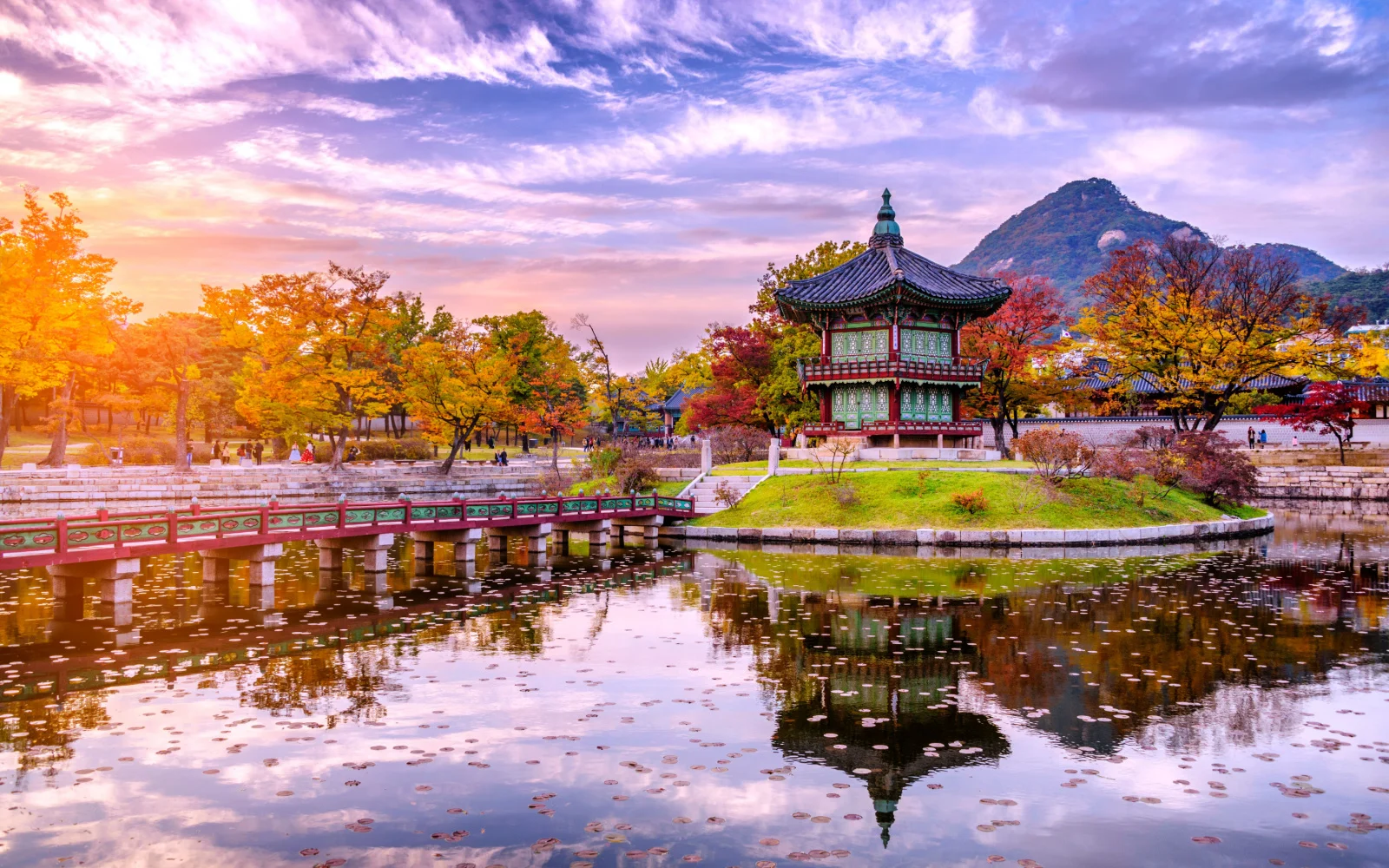What's the best time to visit South Korea?
The best time to visit South Korea is during March to May and October to November, when the weather is pleasantly mild and the scenery is stunning with spring cherry blossoms and autumn foliage.
This period avoids the extremes of summer heat and winter cold, offering ideal conditions for sightseeing and outdoor activities. With temperatures ranging from 50°F to 76°F, it’s a perfect time to explore the country’s cultural festivals and natural beauty.
Vibrant Korean culture set in buzzing modern cities and lush, mountainous landscapes, ancient Buddhist temples contrasting with modern architecture, and stunning subtropical islands with crystal-clear waters and white sand beaches make South Korea an amazing destination.
But what’s the best time to visit South Korea? It depends on what you want to see, do, and experience while you’re there, along with your budget and travel preferences.
Overall Best Time to Visit South Korea
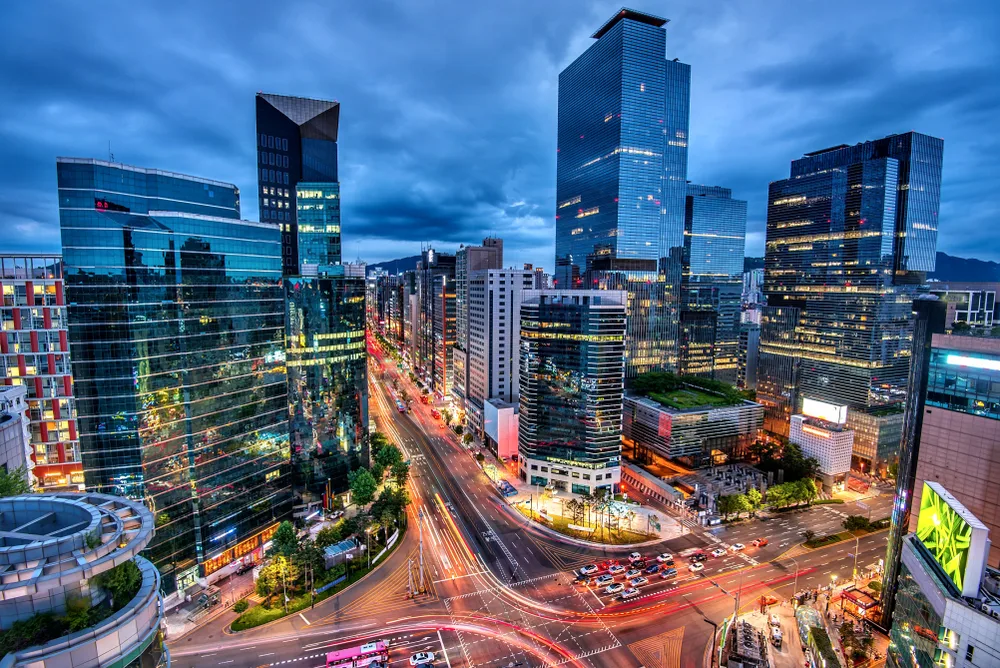
Sayan Uranan/Shutterstock
The best time to visit South Korea is March to May and October to November, when weather is mild and nature comes to life with blooming flowers and greenery, then colorful fall foliage.
March through May is the most popular season to visit South Korea with blooming cherry trees, lush greenery, and mild, balmy weather with highs from the mid-50s to the mid-70s around the peninsula. Rain is moderate and temperatures are pleasant this time of year:
- March: 50-55°F; 5-8 rainy days
- April: 62-67°F; 6-9 rainy days
- May: 69-76°F; 7-9 rainy days
Once October and November arrive, fall color explodes around South Korea and transforms the hilly and mountain landscapes into rolling hills and rugged peaks in gold, auburn, and deep purple tones. Weather in fall is much warmer than spring with a little less rain:
- October: 66-69°F; 4-6 rainy days
- November: 52-59; 4-6 rainy days
Visiting during either the spring or fall seasons ensures you arrive before or after the short rainy season from June to September and avoid the higher temperatures of the muggy summer season. Both seasons are prime times to explore South Korea’s cities and outdoor spaces.
Spring’s cherry blossom, or sakura, season typically lasts from late March to mid-April and is a major draw for tourists. Seoul and Jeju Island in particular explode in baby pink and white color with their long rows and wild groves of thousands of cherry trees.
South Korea’s hotel prices are very reasonable this time of year, with March being one of the cheapest months to visit the country overall. We compiled and averaged Google Hotels data across South Korea to find the average rate per night for 2-5 star hotels:
- March: $94/night
- April: $108/night
- May: $126/night
- October: $129/night
- November: $96/night
While the hotel prices in May are on the high end of average for the country, it’s still an affordable time to visit compared to Japan (almost twice as expensive on average this month). And October is the cheapest month to fly to South Korea overall!
- Lotus Lantern Festival (Apr./May): Seoul marks the anniversary of Buddha’s birthday with a traditional lantern festival downtown, where colorful lanterns are strung up and people light lotus-shaped prayer candles
- Yeongdeungpo Yeouido Spring Flower Festival (Apr.): Famous cherry blossom festival in Seoul’s Yeouido neighborhood, where 1,886 cherry trees burst into bloom around April with Korean food stalls, exhibits, live music, and more
- Chuseok Harvest Festival (Sept.): A 3-day mid-autumn festival of thanksgiving and harvest abundance, celebrated with songpyeon rice cakes, games, and cultural traditions; sometimes called the Moon Festival
- Seoul International Fireworks Festival (Oct.): People gather by the thousands to watch impressive fireworks displays at the Yeouido Han River Park in the heart of Seoul
- Gangneung Coffee Festival (Oct.): Coffee roasters, shops, and growers come to the “City of Coffee” on the coast for seminars, samples, and food stalls offering small bites with coffee drinks
- Busan International Film Festival (Oct.): Held annually in Haeundae-gu, Busan, this popular film festival brings together filmmakers, directors, and actors from around the world for screenings
Both seasons are perfect to explore the fascinatingly opulent Gyeongbokgung palace built in traditional style in Seoul, then wander through the 15th-century Namdaemun Market to browse merchandise, fresh seafood, and Korean street food stalls.
Spring is a good time to visit Jeju Island and its Hallasan National Park to hike mountain trails, while October is a good time to visit the island for its pristine beaches or head to the mountainside Buddhist Beomeosa Temple in Busan, surrounded by fall color.
Cheapest Time to Visit South Korea
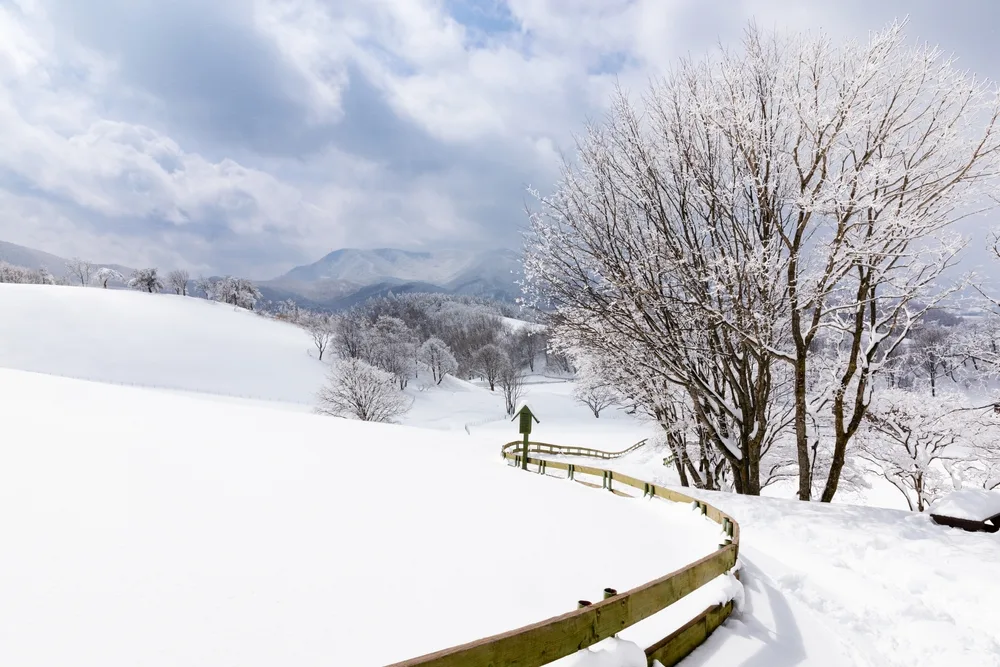
Yousuk Yang/Shutterstock
The cheapest time to visit South Korea is November and January through March, when hotel prices drop in tandem with the temperatures around the peninsula.
The weather isn’t quite as welcoming in South Korea during the winter season, but the prices are! With the exception of December, which is the most expensive month to visit, November and January-March see the lowest prices of the year.
Cool to cold temperatures are the norm during the late fall and winter season, with the bookend months (November and March) seeing milder weather with highs in the low-to-upper 50s. January is the snowiest month, while February receives a little snow on average:
- November: 52-59; 4-6 rainy days
- January: 34-46°F; 3-5 rainy/snowy days
- February: 40-47°F; 3-6 rainy/snowy days
- March: 50-55°F; 5-8 rainy days
The chance for snow in January and February is great news if you’re hoping to head to some of South Korea’s popular ski resorts in the mountains, like Alpensia Ski Resort in Pyeongchang. Resorts in Korea also spray artificial snow since even the highest altitudes don’t receive more than an inch of snowfall per month.
You’ll find the most affordable prices on hotels throughout South Korea during November, January, February, and March, according to data we’ve sourced from Google Hotels and averaged to find 2-5 star hotel nightly rates by month:
- November: $96/night
- January: $95/night
- February: $92/night
- March: $94/night
If you’re looking for the absolute cheapest month to visit, January is your best bet. Not only does it have one of the lowest average nightly rates for hotels, but it’s also one of the cheapest months for airfare to South Korea, according to Skyscanner data.
- Geoje Island Flower Festival (Nov.): Held in Geoje, Gyeongsangnam-do, this autumn bloom-filled festival fills the air with sweet fragrance as people browse merchandise, admire flower sculptures, art exhibits, and live music
- Busan Fireworks Festival (Nov.): Fireworks displays light up the skies over Gwangalli Beach, Busan in one of the country’s most popular festivals showcasing special lighting on buildings and bridges, music, and food stalls
- Korean New Year (Jan./Feb.): A 3-day holiday, Seollal, where families gather to celebrate the first day of the new year using the lunisolar calendar with feasts, parades, and traditional customs to honor ancestors
- Daeboreum (Feb.): Full-moon festival honoring the first full moon of the new year with parades, performances, traditional dress, signature Korean dishes, and Daljip, or bonfires
Winter is a great time to visit the Lotte World amusement park in Seoul, where there’s an entire indoor park and ice skating rink inside of a massive glass dome to keep out the cold air.
Take a warm, enclosed cable car up to N Seoul Tower for incredible views over the capital city, then check out the charming Bukchon Hanok Village in Seoul and make your way down its snowy, narrow streets for great photo opportunities.
Wander the Hongdae district of Seoul to try street food, visit shops, and catch K-pop performances. You can admire the colorful lights at the Garden of Morning Calm Arboretum just east of the city from December through March.
Least Busy Time to Visit South Korea
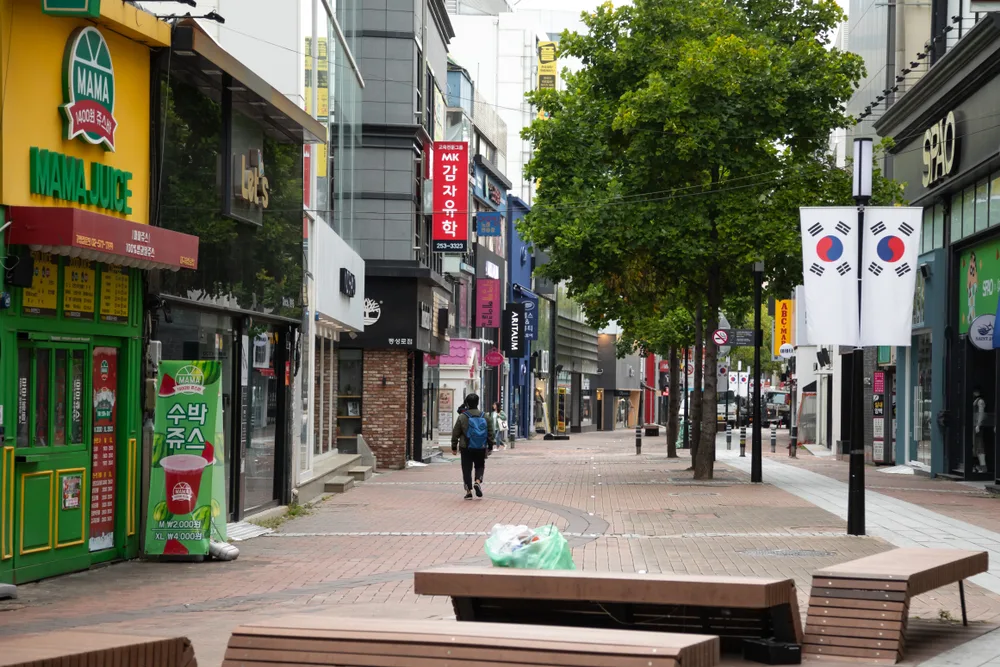
Janggwan-Dong, Daegu, South Korea – October 9 2018: View up an empty shopping district and commercial street in downtown Daegu/VDB Photos/Shutterstock
The least busy time to visit South Korea is during January and February and the month of July, when the country sees fewer tourists in the face of very cold or hot, rainy weather.
January and February are cold with moderate chances of snow and rain, while warm July is part of the humid rainy season in South Korea. These weather “extremes” (for South Korea, at least) are responsible for the smaller crowds this time of year.
- January: 34-46°F; 3-5 rainy/snowy days
- February: 40-47°F; 3-6 rainy/snowy days
- July: 83-85°F; 14-16 rainy days
With high temperatures ranging from the low 30s to the mid-40s in January/February and 3-6 days with rain or snowfall, the winter months can be a good time to visit without big crowds if you’re okay with exploring South Korea in the cold or want to go skiing in the mountains.
July is a different story, bringing highs in the mid-80s with lots of rainfall — around 15 rainy days throughout the month on average. Seoul is one of the rainiest places on the peninsula, seeing 11.6″ of rain this month on average compared to 9.2″ in Jeju City and Daegu.
While the warm temperatures of July make it ideal for visiting Jeju Island for its glistening beaches, Hallasan National Park, and tourist attractions, you’ll have to contend with rain that can throw a wrench into daily beach or hiking plans.
July is also more expensive than January and February in terms of hotel prices (listed below with the help of Google Hotels data), so consider your budget when determining which of the least-busy months are better for your trip.
- January: $95/night
- February: $92/night
- July: $113/night
You’ll find a range of cultural events and festivals taking place across South Korea during the less-busy months of January, February, and July, like these:
- Pyeongchang Trout Festival (Jan.): Locals and tourists gather to ice fish and try barehanded fishing, or noodling, for trout in small pools near Alpensia and Yongpyong ski resorts for this fun, cold-weather festival
- Taebaeksan Mountain Snow Festival (Jan.-Feb.): The snow is formed into impressive sculptures and sledding, live music performances, and food booths set up on Taebaeksan Mountain with a colorful lantern lighting festival nearby at Hwangji Pond
- Chilgapsan Ice Fountain Festival (Dec.-Feb.): Frozen fountains create unique, icy displays while snow sculptures stand around for viewing along with activities like a kid’s train, zip track, bob sleighing, and warm snacks and drinks
- Busan Food Film Festa (Jul.): A South Korean film festival that centers around cinema featuring or focusing on food, while vendors set up offering some of the dishes seen on the silver screen for tasting
- Geumsan Samgyetang Festival (Jul.): Samgyetang, or chicken ginseng soup, is the heart and soul of this food festival during the summer, along with other chicken-centric dishes with Korean flair and activities, performances, and more
- Daegu Chimac Festival (Jul.): Chicken and beer are the stars of this laid-back festival, where multiple varieties of beer and chicken cooked in traditional and new ways are offered for visitors along with performances and well-known restaurants offering samples
- Boryeong Mud Festival (Jul.): Jump into a mud puddle, make mud soap, or get a mud massage in a South Korean city where the mud is delightfully squishy and known for its healing and detoxifying properties
Winter is a great time to visit the Gamcheon Village in Busan, where the houses and buildings are delightfully colored in pastel and terracotta colors and there are lots of shops and cafes to check out.
The E-World theme park in Daegu comes to life with E-World Illumination during the winter months, making it (and the 83 Tower for great views) an awesome place to visit during January and February with smaller crowds than peak season.
Take a 45-minute bus ride from Suncheon to the enchanting Seonamsa Temple and monastery in the mountains during July, where you’ll find the air cooler than at lower altitudes and a refreshing chance to check out this UNESCO World Heritage Site.
Worst Time to Visit South Korea
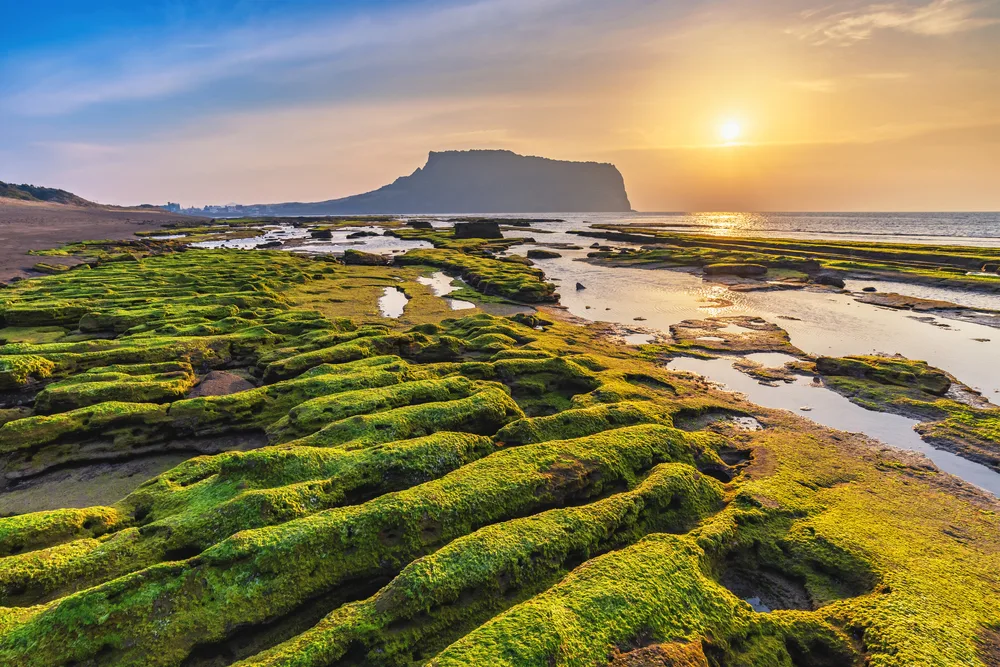
The summer rainy season, from June to August, is the worst time to visit South Korea due to hot temperatures, muggy conditions, and up to 16 rainy days each month.
Warm to hot summertime temperatures in South Korea could be ideal for visiting its beaches, especially on Jeju Island, in Busan, and Gangneung, but then there’s the rain. With anywhere from 9-16 rainy days during each of these months, summer is a wet affair here.
- June: 76-81°F; 9-12 rainy days
- July: 83-85°F; 14-16 rainy days
- August: 84-86°F; 13-14 rainy days
June is your best bet for escaping torrential downpours and the highest temperatures of the summer (which come in July and August), but it’s still a wet month that can make trips to the beach a bit dicey.
The hot, rainy, and humid conditions during June, July, and August make it a less favorable time to travel to South Korea, but the price you’ll pay to deal with frequent showers and storms adds insult to injury this time of year.
Here’s a look at the average price per night for 2-5 star hotels across South Korea, according to Google Hotels data we’ve compiled and analyzed:
- June: $109/night
- July: $113/night
- August: $130/night
While June and July offer reasonable rates for accommodations, August is one of the most expensive months for hotels in South Korea and with 13-14 rainy days in the forecast, it may not be worth it to travel during this month if you’re hoping to go to the beach or spend time outside sightseeing and exploring the cities.
There are several events and festivals that happen during the rainy summer months, which can be a great way to experience South Korea’s culture. Along with the July events listed above under the Least Busy Time to Visit, here are more events to keep on your radar:
- Incheon Pentaport Rock Festival (Aug.): The biggest rock music festival in South Korea, this one features international artists and bands from the U.S., Europe., Japan, Korea, and more with food booths, merchandise booths, and picnic zones
- Jeongnamjin Jangheung Water Festival (Jul.-Aug.): Squirt gun fights with thousands and water sports make this festival unforgettable by the Tamjingang River in Jangheung, featuring a Salsu Battle Street Parade and live music by the pool
While June through August is a tough time to visit with the heat, rain, and higher prices at the end of the season, you can still enjoy your visit by planning some fun things to do around the peninsula.
It can be a good time to head to the beaches on the east coast and offshore islands, like Haeundae Beach, Busan, Hyeopjae Beach, Jeju Island, and Seobin Beach, Udo. Make backup plans (like visiting restaurants, bars, shops, malls, and museums) in case the rainfall ruins your beach day.
Speaking of museums, you’ll want to visit the National Museum of Korea in Seoul to learn about Korean history and culture among art and artifact exhibits. You can stop by the Seoul Museum of History while you’re in the city, too.
Songdo Central Park is modeled after NYC’s famous park and really nice to visit if you find yourself in Incheon for the rock festival in August!
Things to Consider
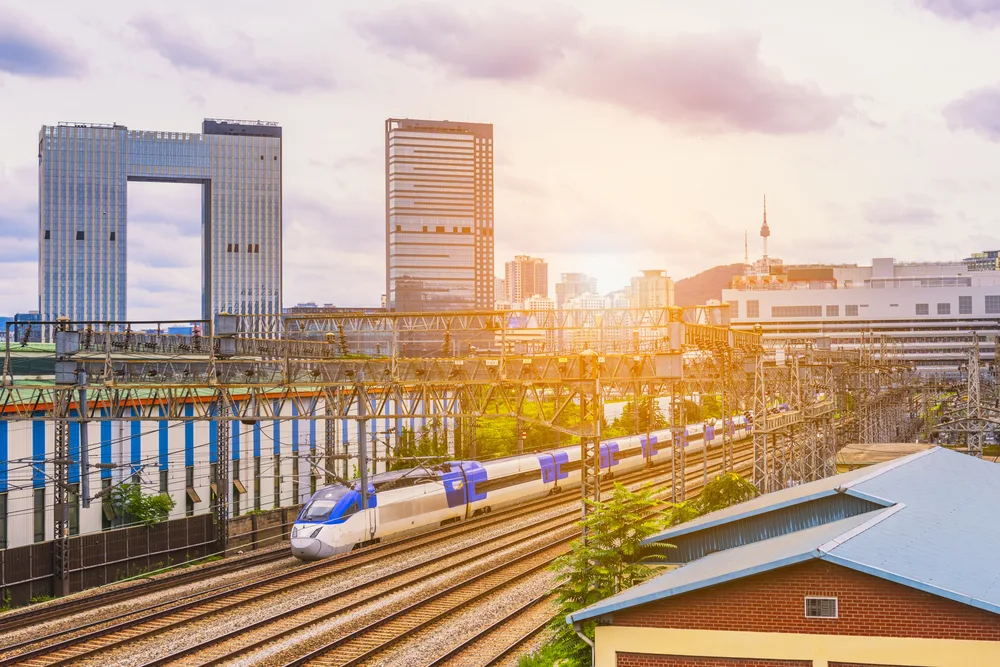
Seoul Subway KTX train traffic in Seoul City,South Korea/CJ Nattanai/Shutterstock
You’ll have a better experience when you visit South Korea anytime of year if you keep these travel tips and considerations in mind while you plan.
- Know what to pack by season. South Korea’s seasons range from freezing cold winters to hot, rainy summers with mild spring and fall seasons. If you’re visiting during one of the “extreme” months (winter or summer), pack accordingly with warm layers and accessories or lightweight clothing, sunscreen, hats, and umbrellas. Spring and fall call for layers you can shed or add, and all seasons require comfortable shoes for walking or hiking.
- Understand regional weather differences. Jeju Island is about 10° warmer than the capital, Seoul, during the winter months. All regions of South Korea tend to sync up in terms of weather from March through November, when temperatures hang within 1-5 degrees around the peninsula and offshore islands.
- Mind the language barrier. While you’ll find some Koreans who speak English in the larger cities, it’s less common in rural areas away from tourist zones. Learning a few Korean phrases and using the Google Translate App can help you communicate and check menu and sign information.
- Respect the culture. The Korean culture thrives even today with customs and traditions from ancient times, so it’s important to show respect when visiting. From chopstick etiquette to avoiding certain hand gestures, like beckoning someone with your palm facing up, there’s a lot to consider before traveling.
Frequently Asked Questions
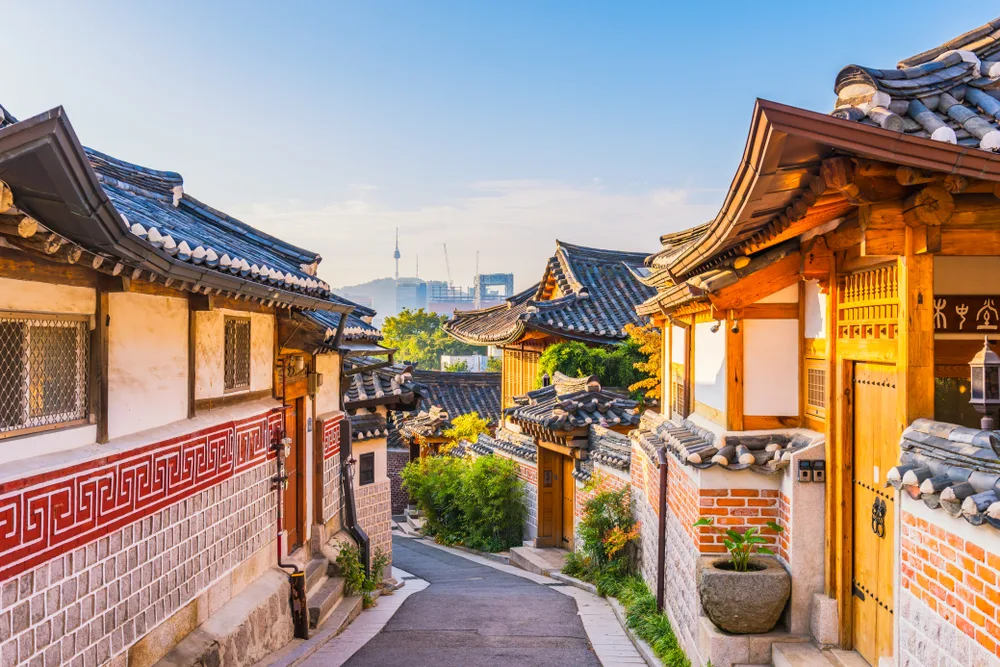
CJ Nattanai/Shutterstock
Going during the best time to visit South Korea doesn’t automatically guarantee a great time, but studying up on the most frequently asked questions might help!
What is the best month to go to South Korea?
April is the best month to go to South Korea, since it’s when you’ll find the sakura, or flowering cherry trees, in bloom during the famous cherry blossom season. April rivals Japan in South Korea with its colorful flowers, mild, warm temperatures in the low-to-upper 60s, and minimal rainfall.
October is another great month to visit South Korea to see the fall foliage. Mountains, hills, and city parks are decked out in autumn shades as the leaves change color. Temperatures hover in the mid-to-upper 60s and make for pleasant time to spend outdoors.
What is the cheapest time of year to fly to South Korea?
The cheapest time of year to fly to South Korea is during October, which sees the lowest airfare from the United States to South Korea and may mean flights as low as $628, according to Skyscanner flight data.
But November and January through March are the cheapest months to visit Korea, owing to the lower hotel and attraction prices during the winter off-season. January is among the cheapest months to fly and makes a great, affordable time to visit.
Which season is the most beautiful in Korea?
The most beautiful season in Korea is a toss-up between the balmy cherry blossom, or sakura, season in the spring (late March to mid-April) and the colorful, mild fall season (especially October and November).
Both seasons feature less rain than summer, but fall is a bit drier and better for spending time outdoors. What’s more appealing to you -- rows of cherry trees bursting with pink and white petals, or golden and red shades rippling through the mountains and hillsides?
What is the rainy season in South Korea?
The rainy season in South Korea is the summer, from June to August. These months can see anywhere from 9 to 16 rainy days in a 30-day period, making them the wettest months of the year and much more difficult if you’re planning on sightseeing or exploring outside.
It’s a good idea to make indoor plans as a backup if you’re visiting during the rainy season, so make a list of museums, restaurants, and shops you’d like to visit where you’re staying.
How many days is enough for South Korea?
Generally speaking, 7-10 days is enough for South Korea if you want to get a well-rounded take. This gives you enough time to explore Seoul, the capital, and its historic villages, visit a beach or two, and hike or bike in the mountains.
So, What’s the Best Time to Visit South Korea?
The spring and fall months, March to May and October to November, are generally the best time to visit South Korea overall. Mild weather, less rain, and ample opportunities to get out and explore, sightsee, and experience Korea’s most beautiful blooms or fall color make these seasons ideal.
Saving money on your trip to Korea means visiting during the month of November, January, February, or March. This is when you’ll find the best prices on hotels and flights to make your visit more affordable, but it can be cold and snowy.
January, February, and July are the least busy months to visit, and you’ll either experience cold temperatures with chances of snow or hot temperatures with 14-16 rainy days. Avoid visiting during the rainy summer season from June to August, which sees lots of rainfall for 9-16 days each month and cloudy skies, along with higher prices in August.
The magic of South Korea is in its colorful culture, ancient temples, modern architecture, flavorful food, and amazing destinations from beaches to mountains and metropolises. Anytime you visit is sure to send you home with stories to tell and lifelong memories!



